Feeding your parrot isn’t just about keeping their belly full—it’s about giving them the right fuel to stay happy, healthy, and energized every day. When you prepare food for your parrot at home, you get full control over what goes into their diet, and that means no mystery ingredients or low-nutrient fillers. You can focus on fresh, wholesome ingredients that support their health and satisfy their taste buds.
Whether you’re a new parrot parent or looking to improve your bird’s current meals, this guide will help you whip up simple, nutritious dishes that your feathered friend will absolutely love. From fruity snacks to hearty grain bowls, we’ll share five easy homemade meals that blend avian nutrition with flavors your parrot will look forward to at every feeding time.
Let’s dive into the best home-cooked food options for parrots—made with love, straight from your kitchen.
Fresh Fruit & Veggie Medley (A Colorful, Vitamin-Rich Treat)
Include Bird-Safe Fruits Like Apples, Bananas, and Berries
Parrots love sweet, juicy fruits, and many of them are not only delicious but also packed with essential nutrients. Apples (without seeds), bananas, blueberries, strawberries, and mangoes are all great options. These fruits provide natural sugars for energy, along with important vitamins like A, C, and K. Always chop fruits into manageable pieces to prevent choking and keep your parrot engaged during mealtime. Offering a variety ensures they get a mix of nutrients and flavors they enjoy.
Add Leafy Greens and Chopped Vegetables Like Carrots, Bell Peppers, and Spinach
Vegetables play a huge role in your parrot’s daily diet. Bright, colorful options like bell peppers and carrots are full of beta-carotene, which supports immune function and healthy vision. Dark leafy greens like kale, spinach, and romaine lettuce offer calcium and other minerals that boost bone strength and overall wellness. Chopping veggies into small, bite-sized pieces makes them easier to eat and encourages parrots to try new textures. You can even mix and match veggies to keep their meals exciting.
Benefits of Fruits and Veggies for Parrots (Fiber, Vitamins, Hydration)
A well-rounded mix of fruits and vegetables provides parrots with more than just taste—it fuels their body with hydration, vitamins, and dietary fiber. Fiber supports digestion, while vitamins A, C, and E help with skin, feather health, and immune defense. Plus, fruits and vegetables are water-rich, which helps keep your bird hydrated, especially during warmer months. When you prioritize fresh produce as part of the food for parrot at home, you’re creating a strong nutritional foundation for long-term health.
Parrot Feeding Tips: Serving Size, Washing Produce, and Frequency
Always wash fruits and vegetables thoroughly to remove pesticides and dirt before feeding. Organic options are best when available. Keep portion sizes appropriate for your parrot’s size and activity level—too much fruit can lead to excess sugar intake, while too many greens might cause calcium imbalance. Offer fresh produce daily, but rotate the types of food to avoid boredom and ensure a full spectrum of nutrients. Watch your bird’s reactions and adjust based on their preferences and health needs.
Warm Quinoa & Seed Bowl (Protein-Packed DIY Parrot Diet)
Cooked Quinoa Mixed with Soaked Seeds and a Touch of Coconut Oil
Quinoa is a powerhouse grain that’s rich in protein, fiber, and essential amino acids—making it a fantastic base for homemade parrot meals. When you prepare quinoa, rinse it thoroughly to remove its natural coating (saponin), which can cause bitterness or digestive issues. After cooking it soft and fluffy, mix in a handful of pre-soaked seeds like sunflower, flax, or chia. Soaking seeds helps our bodies digest them better and makes more good nutrients available. A small drizzle of coconut oil adds a boost of healthy fat and gives the dish a lightly sweet aroma that parrots often enjoy. This warm, soft mix is comforting and filling—perfect for parrots during cooler months or after lots of activity. It’s one of the most nourishing components you can include when crafting food for parrot at home.
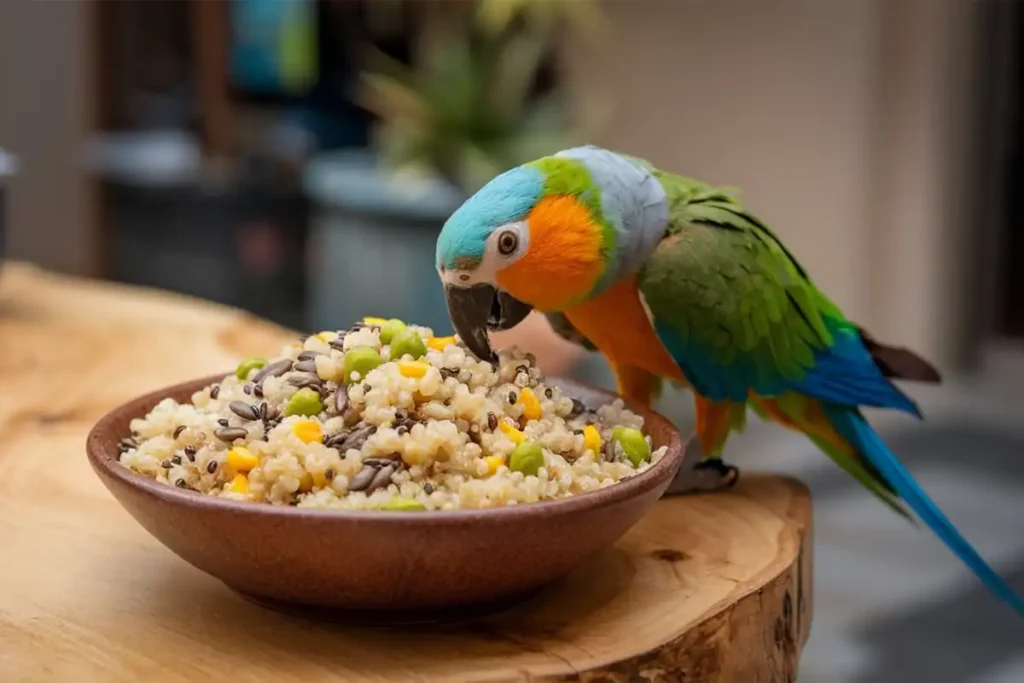
Add Steamed Peas, Sweet Corn, or Finely Diced Squash
To enhance the quinoa and seed base, mix in a selection of lightly steamed vegetables. Green peas and sweet corn are not only high in natural sugars and fiber but also packed with vitamins and minerals that support eye health, digestion, and immune strength. Butternut squash or pumpkin is another great option—rich in beta-carotene and incredibly tasty to most parrots. Steaming these veggies softens their texture and makes them easier for birds to eat while preserving most of the nutrients. Cut the pieces small enough for your parrot to grab easily, or mash them slightly to blend with the quinoa mix. These additions make the meal colorful, appealing, and even more nutritionally complete.
Great Source of Plant-Based Protein and Healthy Fats
This quinoa and veggie bowl delivers a solid balance of plant-based protein and good fats, which are both critical for parrots’ muscle health, feather condition, and energy levels. Unlike some commercial bird foods, this meal gives you full control over every ingredient—no fillers, no preservatives, just clean nutrition. The protein from quinoa and peas supports tissue repair and immune function, while the fats from seeds and coconut oil help regulate body temperature and keep skin and feathers in top shape. A DIY bowl like this not only nourishes your bird but also mimics the variety they’d encounter in the wild.
Safe Food Preparation Tips for Pet Birds
Always focus on cleanliness and moderation when preparing homemade meals. Use fresh, high-quality ingredients and clean all produce thoroughly before cooking. Do not add any salt, spices, or oils, except for a small amount of bird-safe coconut oil. Never serve food that’s too hot—let warm dishes cool to room temperature before offering them to your parrot. Prepare smaller portions so nothing goes to waste, and store leftovers in a sealed container in the fridge for no more than 1–2 days. When introducing new foods, watch your parrot closely to make sure they tolerate the ingredients well. With the right prep and portioning, you’ll make every mealtime safe and satisfying.
Nutty Oat Mash (Comforting & Energy-Boosting Parrot Meal)
Rolled Oats Cooked with Water, Mixed with Crushed Nuts (Like Almonds, Walnuts)
Rolled oats are an excellent choice when you’re looking to make a warm, filling meal for your parrot. Oats are gentle on the digestive system and packed with fiber, which supports healthy digestion and helps maintain a steady energy level throughout the day.
When cooked with water (never milk or flavored liquids), they become soft and easy for parrots to eat. After cooking, let the oats cool to room temperature, then stir in a small portion of crushed or finely chopped nuts. Parrots love the crunch and flavor of raw almonds, walnuts, or hazelnuts. These nuts are good for you because they have healthy fats, vitamin E, and protein. These ingredients are important for strong muscles, healthy feathers, and a shiny, beautiful coat. This oat and nut combo creates a hearty base that’s both delicious and packed with nutritional benefits. It’s a fantastic, wholesome option to include in your routine when preparing food for parrot at home.
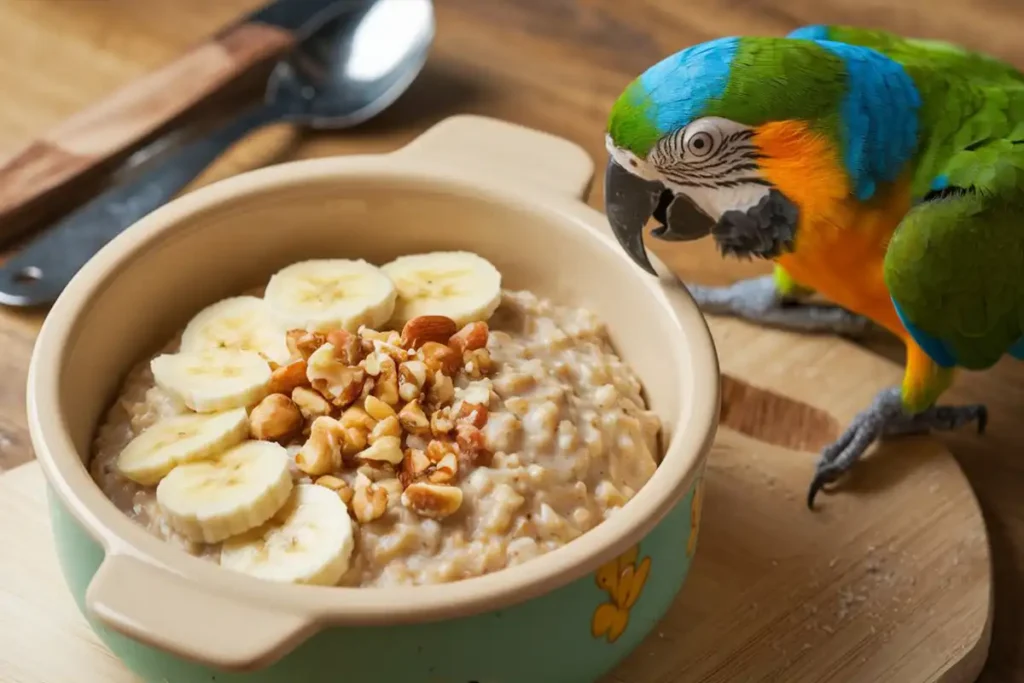
Add a Few Slices of Fruit for Sweetness (Banana or Mango)
Parrots have a natural sweet tooth, and adding fruit to their warm oat mash can make the dish even more appealing. Slice up some ripe banana, mango, or papaya, and mix it gently into the oats. These fruits add not just flavor but also important nutrients. Bananas provide potassium and vitamin B6, which support nerve and muscle health. Mangoes offer beta-carotene and vitamin A, vital for eye and skin health. By incorporating a small variety of fruit into this dish, you’re turning a simple oat meal into a colorful, flavorful treat that keeps your parrot excited about mealtime. Be sure to cut the fruit into small pieces to prevent choking and avoid overdoing the portion—fruit should be a complement, not the bulk of the dish.
Ideal for Active Parrots or Colder Days
This oat-based meal is especially useful for days when your parrot needs extra fuel. Whether your bird is highly active, going through a molt, or simply dealing with colder temperatures, this warm, energy-dense food helps keep them strong and comfortable. The carbohydrates from the oats provide slow-release energy, while the nuts and fruits offer quick fuel and added nutrients. Serving this meal in the morning is a great way to start your parrot’s day—it gives them a nutritious boost and sets the tone for active play, vocalizing, or social interaction. During winter months, this warm dish also brings a sense of comfort and helps support body temperature regulation, especially in tropical birds that aren’t used to the chill.
Discuss Moderation in Nuts Due to Fat Content
While nuts are incredibly beneficial in small amounts, it’s important to use them carefully. They’re calorie-dense and high in fat, which can lead to weight issues or fatty liver disease in parrots if overfed. For smaller parrots like lovebirds, parrotlets, or cockatiels, even a teaspoon of nuts might be too much. Larger parrots like African greys or macaws can tolerate a bit more, but you still need to keep portions modest. Choose raw, unsalted nuts only—no roasted or flavored options. Nuts should act as a healthy topping, not the foundation of the meal. Balance them with low-fat ingredients like vegetables, oats, and fruits to keep your parrot’s diet heart-healthy and well-rounded. Pay attention to their body condition and energy levels, and adjust accordingly to keep them thriving.
Veggie Skewer Snacks (Fun, Enriching Mealtime for Pet Birds)
Skewer Chunks of Parrot-Safe Veggies and Fruits for Foraging Fun
Making food skewers is a fun way to make eating more enjoyable and interactive. Simply thread bite-sized chunks of parrot-safe fruits and vegetables onto a bird-safe skewer and hang it in your parrot’s cage or play area. Use colorful ingredients like apple slices, grapes, bell peppers, cucumbers, carrots, zucchini, or strawberries to make the skewer visually appealing and nutritionally diverse. This interactive feeding method taps into your bird’s natural foraging instincts, encouraging them to work for their food while having fun. Not only does it keep your parrot mentally stimulated, but it also slows down eating, which can aid digestion. When preparing food for parrot at home, adding variety in both flavor and presentation—like a vibrant skewer—keeps your bird entertained and nourished.
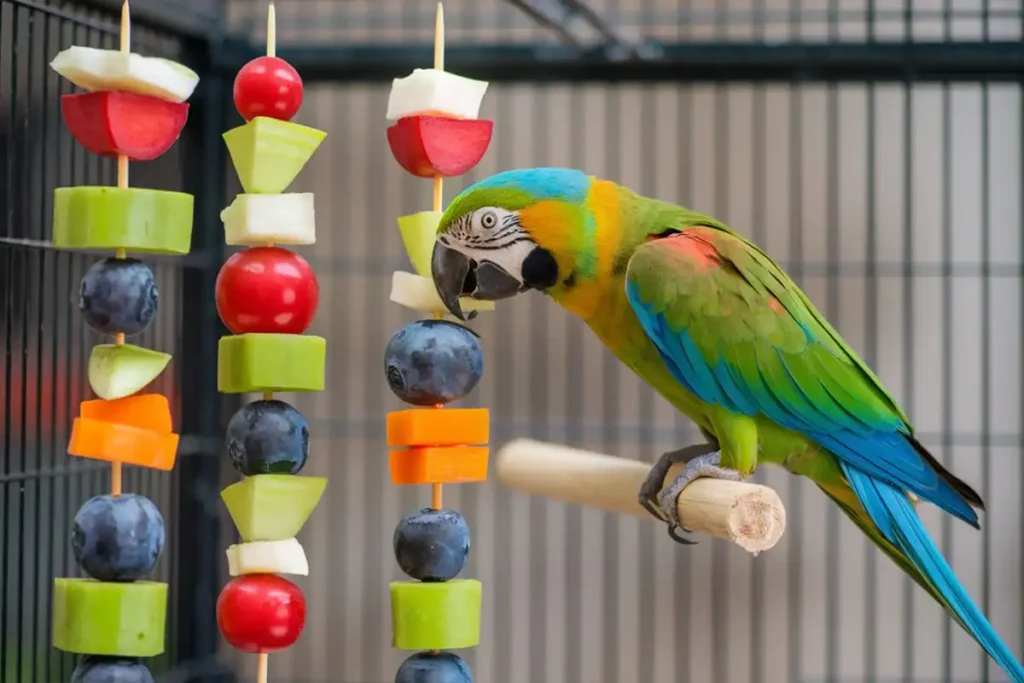
Encourages Natural Chewing and Play Behavior
Parrots in the wild spend a huge portion of their day foraging, chewing, and exploring food. A skewer full of textures—crunchy carrots, juicy fruits, soft squash—lets them mimic that same behavior at home. This kind of feeding setup doesn’t just offer nutrition—it supports your parrot’s beak health, relieves boredom, and helps prevent destructive habits that can arise from lack of stimulation. Chewing also helps with stress relief and overall enrichment, particularly for intelligent bird species like conures, African greys, or macaws. The simple act of tugging and pulling food from a skewer engages their mind and keeps them occupied in a healthy, constructive way.
Rotate Ingredients to Keep It Exciting
Just like us, parrots can get bored of eating the same thing every day. To keep your bird interested, rotate the fruits and vegetables on their skewer regularly. One day you might offer a mix of banana, red bell pepper, and cucumber; the next, try squash, apple slices, and blueberries. This constant variety not only keeps mealtimes fun but also ensures a wider range of nutrients in your parrot’s diet. The more different textures and flavors your parrot experiences, the more adventurous and well-rounded their eating habits will become. Rotating ingredients also gives you a chance to observe what your bird loves most—and what they tend to ignore—so you can fine-tune their meals.
Safety Tips: Avoid Sharp Skewer Tips and Unsafe Foods
When making skewers, safety always comes first. Pick skewers made for birds. These are often made of stainless steel and have rounded ends or are covered with plastic to keep birds safe from getting hurt. Never use sharp kitchen skewers, toothpicks, or wooden sticks that might splinter. Make sure all fruits and vegetables are washed thoroughly to remove pesticides, and avoid any foods that are toxic to parrots, like avocado, onion, chocolate, caffeine, and fruit seeds. Secure the skewer tightly to prevent it from falling or swinging too aggressively while your parrot plays. And as with any fresh food, remove leftovers within a few hours to avoid spoilage. By following a few simple safety steps, you’ll ensure that this fun feeding method is not only enjoyable but also completely safe for your feathered friend.
Chopped Mix Platter (Balanced & Customizable Daily Staple)
Base: Chopped Greens, Grains, Legumes, and Finely Diced Veggies
Creating a fresh, homemade parrot bowl starts with building a nutritious base made up of greens, whole grains, legumes, and vegetables. Start with a mix of dark leafy greens like kale, collard greens, romaine, or Swiss chard. These leafy options provide essential vitamins like A and K, as well as calcium and fiber. Add in cooked grains such as quinoa, brown rice, barley, or millet, which offer energy, protein, and a satisfying texture parrots enjoy. To boost the protein content and variety, include cooked legumes like lentils, chickpeas, or black beans—be sure they’re plain, soft, and free from any seasoning. Finish the mix with a colorful selection of finely diced vegetables like carrots, bell peppers, zucchini, or green beans. This combination ensures your parrot receives a range of nutrients and textures in every bite, making it a top choice when preparing food for parrot at home.
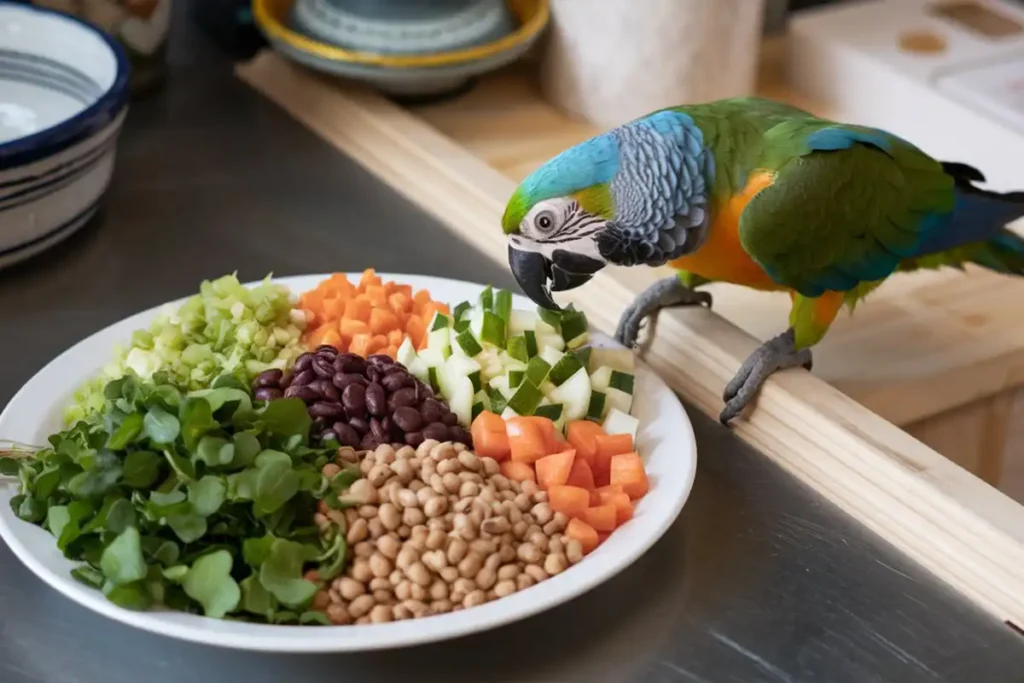
Rotate Weekly to Provide a Balanced Parrot Diet
Variety is one of the most important aspects of avian nutrition. Rotating the ingredients in your parrot bowl weekly helps cover all the nutritional bases and keeps your bird interested in eating. Each week, swap out some of the grains, greens, legumes, or vegetables to introduce different flavors and nutrients. For example, if you used quinoa and spinach one week, try barley and collard greens the next. This practice prevents dietary gaps and reduces the risk of nutrient imbalances. Regular rotation also mimics the foraging experience parrots would have in the wild, encouraging natural eating habits and keeping mealtimes exciting. A varied, colorful bowl not only looks appealing but also supports your parrot’s long-term health.
Store in Fridge in Small Batches for Easy Feeding
To make your life easier and ensure freshness, prepare the parrot bowl in small batches and store portions in airtight containers in the refrigerator. This keeps ingredients fresh for up to two to three days, depending on what’s included. Divide your mix into daily servings so that each day you can simply scoop and serve—no extra prep needed. Make sure to remove any uneaten portions from your parrot’s bowl after a few hours to avoid spoilage. Keeping your food prep organized not only saves time but also helps maintain consistent feeding habits. Your bird will quickly recognize their daily bowl and look forward to mealtimes.
Tips on Introducing New Foods Slowly
Parrots can be cautious or even picky when it comes to unfamiliar foods, so introducing new ingredients slowly is key. Start by adding just one new item at a time to their existing favorites. For example, mix a few lentils into their usual quinoa, or tuck some finely chopped kale under their favorite carrots. Observe how your bird reacts—some may take a few days to even touch a new food, while others dive in with curiosity. Avoid forcing or rushing the process; instead, offer the new item consistently and in different ways. You can also try offering new foods in different textures—raw, steamed, or mashed—to see what your parrot prefers. Be patient, encouraging, and always celebrate even the smallest progress. Over time, this gentle approach will help expand your bird’s diet and make them more open to new, nutritious foods.
Conclusion
Choosing the right food for parrot at home is one of the best ways to show love and care for your feathered friend. By preparing fresh, nutritious meals yourself, you take control of your parrot’s health and happiness. Store-bought pellets and seed mixes can’t always meet your bird’s full nutritional needs, but home-prepared meals allow you to use safe ingredients and create a balanced diet tailored specifically for your parrot.
When you focus on healthy food for parrot at home, you give your bird access to a wide variety of fruits, vegetables, grains, nuts, and proteins. These natural foods boost energy, support feather health, and improve your parrot’s mood. Plus, offering different textures and flavors keeps mealtime exciting and encourages good eating habits.
Don’t forget to monitor what your parrot enjoys most and keep meals interesting with variety. Small changes, like rotating ingredients or trying new recipes, can make a big difference. Always avoid harmful foods like avocado, chocolate, and anything high in salt or sugar.
Feeding your parrot doesn’t have to feel overwhelming. With a little planning and creativity, you can make every mealtime healthy and fun. By consistently offering well-balanced food for parrot at home, you help your pet live a longer, more vibrant life. Start today, and turn your kitchen into a happy, nourishing place your parrot will love.
Discover the best Parrot Food in this Article.
Learn About Green Parrot Food List: What to Feed for a Vibrant, Happy Bird.
Read About Other Pets and breeds From HERE!
Find Out the Best stuff for your Pet On Pet MD Official.
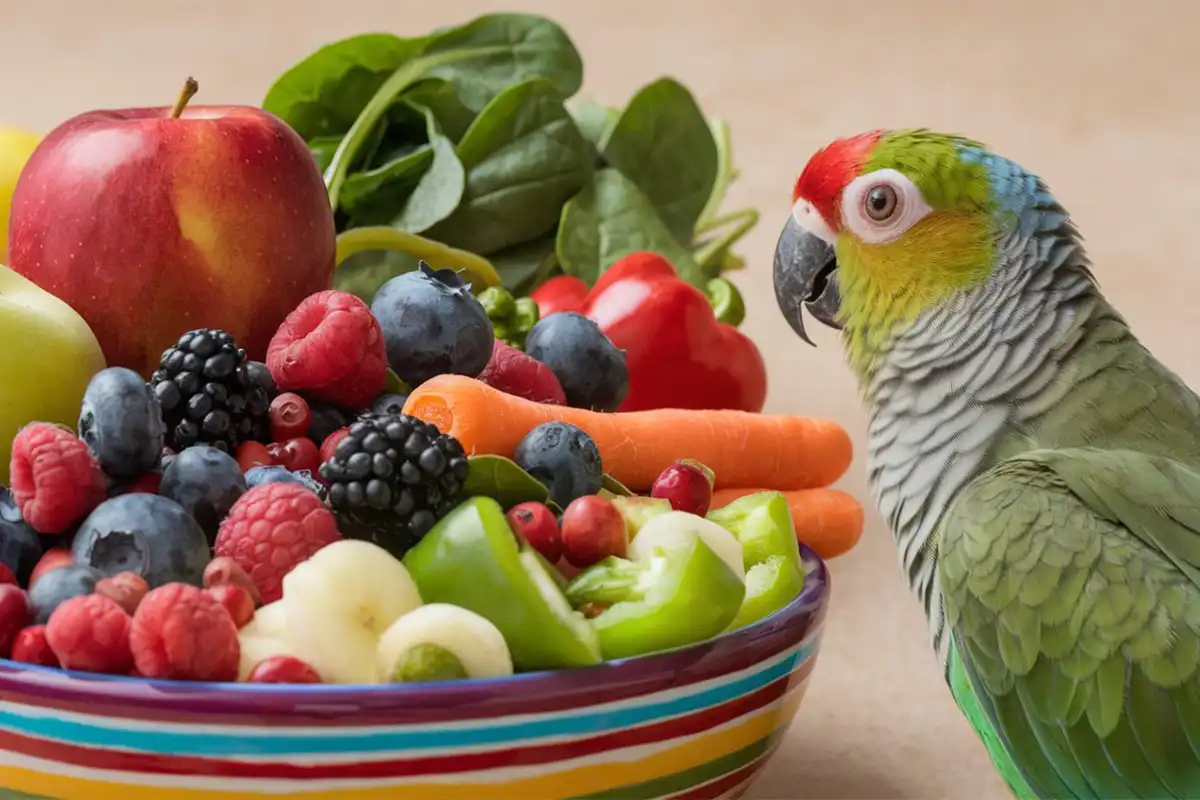
1 thought on “Food for Parrot at Home: 5 Easy, Nutritious Meals They’ll Love!”
Comments are closed.